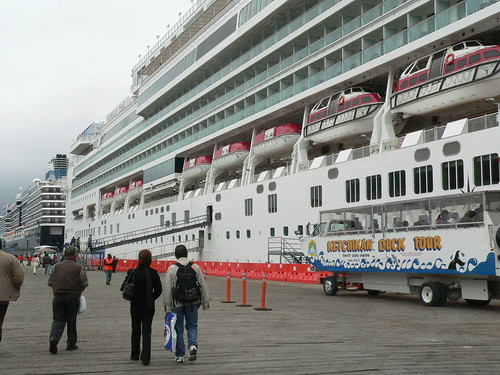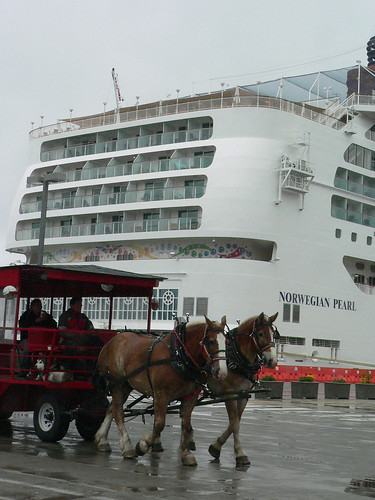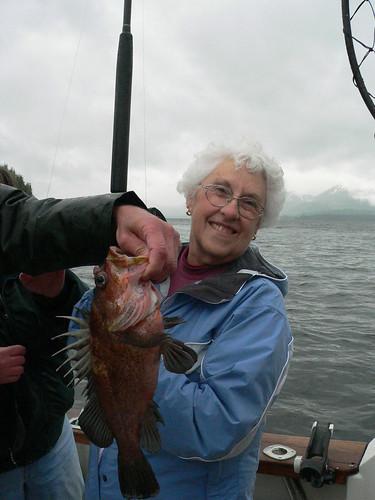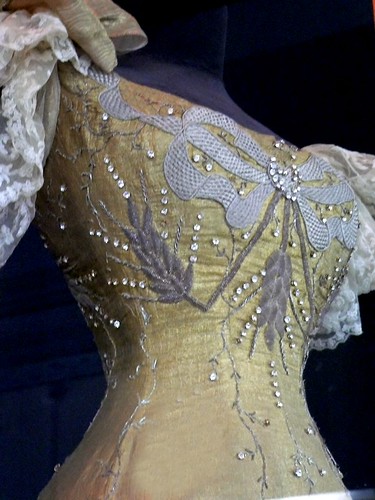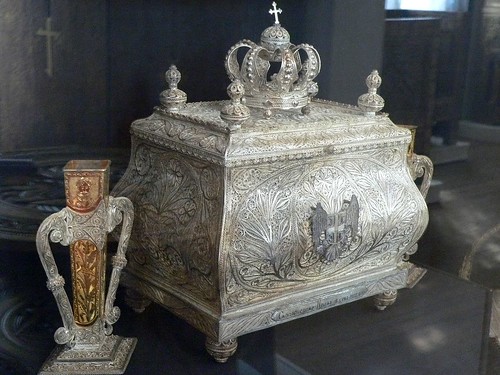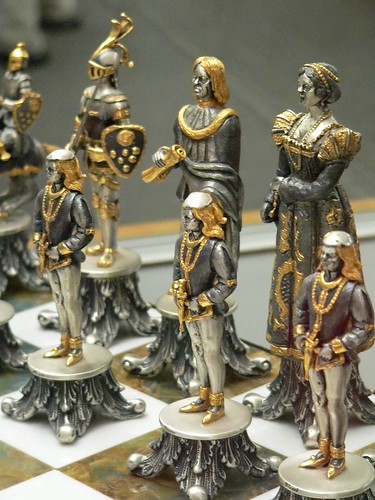Well, I've finally arrived in Naples after a journey from hell. Everything went fine until I reached Munich and the fog was so thick you couldn't see the tip of the aircraft's wing. All the direct flights to Naples were cancelled but by afternoon, Lufthansa booked me on a flight to Milan along with a group of 16 other American women that were flying to Naples to meet a tour group. However, the Milan-bound flight took so long to leave Munich that we missed our connecting flight to Naples.
Lufthansa rebooked us on a later flight to Naples but when it got ready to board, they discovered a mechanical problem so we were told we would have to wait another two hours for another plane to fly in from Istanbul. It finally arrived and ferried us on down to Naples but we arrived with no luggage. Miraculously, AlItalia managed to track it down and return it to me about a month after I came home. The zipper was broken but even my $1500 CPAP machine (I have severe sleep apnea) was intact.
So I had only the dress I was wearing and one change of underwear (I rinsed a pair out every night so it could dry during the day and give me a change for the next day), my computer, camera gear and medication but nothing else.
To top things off, I severely wrenched my right shoulder trying to pack my carryon bag up a 60s style gangway in Munich because the airport doesn't have moveable jetways or at least not for smaller aircraft than those used for long distance trips. They load passengers on a bus that takes you out to the aircraft parked on the tarmac and you must pack your carryon up a stairway.
Anyway, the bus was packed with passengers and when the bus door opened to enable us to disembark the crowd surged forward with someone stepping in front of my carryon and the rest of the crowd pushed me forward causing me to lurch forward while my arm gripping the carryon was pulled backwards. The net result is that now I can't lift my right arm above about waist high without assistance from my left hand which makes taking pictures a rather painful challenge. Still, I was determined to carry on.
I suspected I'd torn the right rotator cuff but if I went to the doctor they would probably put it in a sling and I couldn't take pictures at all then so I stopped at a pharmacy and got a tube of ibuprofen gel to rub into it. I soaked my shoulder in a hot shower then rubbed on the gel and I really do think it helped. Quite honestly I had never heard of this gel version of ibuprophen and I guess I'm not alone because when I mentioned it to my doctor after I got home she didn't seem to have heard of it either.
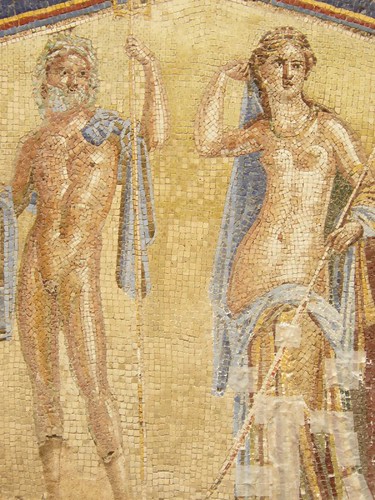 In spite of all this, I managed to photograph all of Herculaneum although I probably took less pictures than I normally would. The beautiful mosaic at right was discovered in the House of Neptune and Amphitrite in the bath complex and is being carefully conserved.
In spite of all this, I managed to photograph all of Herculaneum although I probably took less pictures than I normally would. The beautiful mosaic at right was discovered in the House of Neptune and Amphitrite in the bath complex and is being carefully conserved.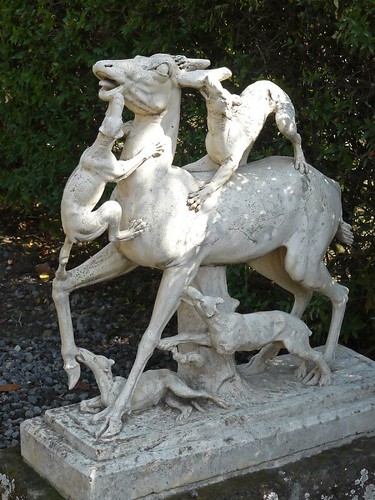
Reproductions of some of the sculpture of the period discovered at the House of the Deer are now displayed on the site (as seen right).
Ancient tradition connected Herculaneum with the name of the Greek hero Herakles (Hercules in Latin and consequently Roman Mythology), an indication that the city was of Greek origin. In actuality, it seems that some primitive forefathers of the Samnite tribes of the Italian mainland founded the first civilization on the site of Herculaneum at the end of the 6th century BC. Soon after, the town came under Greek control and was used as a trading post because of its proximity to the Gulf of Naples. It is the Greeks who named the city Herculaneum. In the 4th century BC Herculaneum again came under the domination of the Samnites.
 The city remained under Samnite control until it became a Roman municipium in 89 BC, when, having participated in the Social War ("war of the allies" against Rome), it was defeated by Titus Didius, a legate of Sulla." - Wikipedia
The city remained under Samnite control until it became a Roman municipium in 89 BC, when, having participated in the Social War ("war of the allies" against Rome), it was defeated by Titus Didius, a legate of Sulla." - WikipediaMore of the multi-story architecture has survived in Herculaneum than in Pompeii although most of the art has been removed and sent to the archaeological museum in Naples. There was still some incredibly bright mosaics in a bath complex though. A few frescoes remain in situ as well although they are pretty faded. There is a lot of conservation work going on though which I was glad to note. I also noticed that some of the columns were painted red just like those portrayed in HBO's "Rome".
It started to rain in the afternoon so my English photographer colleague and I popped into a restaurant. The little "ristorante" was decorated with dozens of colorful ceramic plates that reminded me of the beautiful collection of Maiolica ceramics I had seen at the Legion of Honor Museum in San Francisco last year. I seriously doubt they were made in the 16th century though!
The shopkeeper showed us a little closet that was actually a tiny lift to take us up to the garden level. The tables were arrayed under an overhead trellis covered with vines of some type. I had a nice lunch of ciabatta bread, green salad with tomatoes and Mozzarella cheese, and tortellini in a delicate cream sauce. My colleague Richard ordered a bottle of wine but said afterwards that he doubted if it had ever seen a grape. I asked him what he meant by that and he said that you can produce wine chemically without grape juice and that was probably what had been served. I had never heard of such a thing and since I don't care for the taste of anything with alcohol in it I guess I won't ever care about it.

With still quite a bit of the afternoon to see, we caught the train back downtown to go to the Archaeological Museum. I finally got to see the famous Alexander defeating Darius at the Battle of Issus mosaic which was on my must see list. I had always thought it portrayed the final battle at Gaugamela but all the references say Issus so I guess I have to go with that. I wonder if there was an inscription saying Issus and not Gaugamela? I've also always wondered about the portrayal of Alexander with an out-of-proportion eye compared to the more realistic Persian warriors. I know the "Evil Eye" was much feared in the ancient world so I wonder if this distortion means the conquering Alexander possesses the ultimate source of knowledge and yes, even evil, and is thus unconquerable.
I couldn't get very good pictures of it on my first visit because the museum was full of tour groups and, like the tour groups that visit the Louvre all seeking a peek at the famed Mona Lisa - they clustered in front of it. I had better luck later when I returned on my last day before departure. Mondays apparently are less busy.
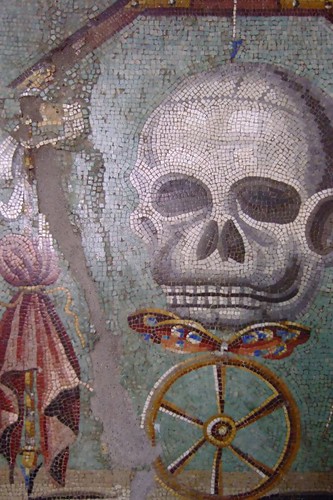 Of course the museum contained many other spectacular mosaics well worth a visit as well. I was surprised to find the mosaic of the Skull image used as the graphic for the intro to HBO's "Rome" miniseries. "Memento Mori" caught my eye immediately as I entered that portion of the gallery. I half expected the little wings beneath the skull to flutter and the skull itself to rock back and forth and Rome's theme music to begin playing since I have seen that graphic so many times as a fan of the series!
Of course the museum contained many other spectacular mosaics well worth a visit as well. I was surprised to find the mosaic of the Skull image used as the graphic for the intro to HBO's "Rome" miniseries. "Memento Mori" caught my eye immediately as I entered that portion of the gallery. I half expected the little wings beneath the skull to flutter and the skull itself to rock back and forth and Rome's theme music to begin playing since I have seen that graphic so many times as a fan of the series! Other mosaics of note included one of the Dioynisian Mysteries, a famous one of animals from the Nile Valley, some with fishes, and one of a cat that looked identical to one I saw on my last trip to Rome in the National Museum.
I managed to get into the "must be over 18 to view' room of erotic art from the brothels and was surprised how mild the images were. Of course the Victorians were pretty prudish. I must admit though, that a couple of Priapine lamps were a bit over the top. I'll have to flag my picture of them "might offend" on Flickr!

Of course I was thrilled to see two famous statues of my "hero" Julius Caesar as well as an impressive colossal bust of Vespasian and an interesting bust of a very young Commodus that did not resemble his father Marcus Aurelius nearly as much as a bust of him as an older man wearing his Hercules lion garb that I saw at the Capitoline Museum in Rome
 There was also a dynamic sculpture of worshippers wrestling with a sacrificial bull that once graced the halls of the Baths of Caracalla in Rome. Apparently it was purchased by a very wealthy Neopolitan family (The Farnesi) so it ended up down here instead of Rome.
There was also a dynamic sculpture of worshippers wrestling with a sacrificial bull that once graced the halls of the Baths of Caracalla in Rome. Apparently it was purchased by a very wealthy Neopolitan family (The Farnesi) so it ended up down here instead of Rome.Day 3
Well, things just don't seem to be working out on this trip. The ibuprofen gel had helped enough with my shoulder that I could take pictures as long as I lifted my one arm with the other one and helped support it but tonight when we were hurrying to catch a bus I didn't see a hole in the pavement and went down really hard wrenching both shoulders pretty severely. I couldn't even pour my own glass of water at dinner or even put the strap of my camera bag over my shoulder. Even typing this note is extremely painful and I've had a shower and doctored both shoulders with the painkilling gel.
To make matters worse, while I was still trembling from the fall, a man in his fifties came up the aisle of the bus and acted like he was just trying to hold on but started pressing his pelvis against my leg (I was sitting on an aisle seat and the bus was crowded and I had nowhere else to go). At first I thought he might just be lurching a little from the bus but the more I tried to scoot away from him the more he pressed against me then his movements became "rhythmical". It was like being raped in public. I didn't know what to do because if I made an issue of it he could just innocently claim he was just trying to hold on. I was also too embarrassed to tell Richard who was watching out the window for street signs so we would get off at the right stop. Thankfully, the man finally moved on. When we got off the bus, I asked Richard if he would let me sit next to the window in the future and I broke down and told him what happened. He was furious someone would try to do that to me so maybe its just as well I didn't say anything at the time. If he had struck the man he probably would have ended up in jail and I don't think his wife would have appreciated that. I know we joked about the old Italian custom of pinching before I left but this type of thing was totally disgusting. I guess I'm not as tough as I try to appear.
Tomorrow we are going to take the lift up to the top of Vesuvius and then spend the afternoon back at the Archaelogical Museum. I think I can do it if I get help on and off the train and Richard carries my camera bag. I don't know if I can manage any pictures but I don't want to spoil it for Richard so I'll just grit my teeth and try not to let it show. I think, though, unless I can get the pain back to a manageable level so I feel I can take care of myself without help, I'm going to cancel my train ticket and my reservation at the hotel in Rome and try to book a flight home.
I don't think I'll be able to work for a week or two except perhaps a little email from home. I'll have to see what the doctor says. I'm going to have to medicate pretty heavily just to try to drive the car back from Portland.
My luggage still hasn't shown up here. At least today I was able to find some underwear, a night gown, and another outfit to wear. I air out the dress i've been wearing overnight but it is surely getting a bit rank after all this time.
Day 4 & 5
The pain was so severe Saturday night that I had the desk call a cab to take me to the orthopedic hospital. I went up to Babelfish before I left for the hospital and wrote out a brief explanation of what happened, where it hurts, a short medical history, and my insurance and contact information and translated it all into Italian. The ER physician's assistant seemed to understand it so I guess the translation wasn't too bad. They X-rayed my shoulder and said there was no fracture but tied it up with a sling to keep me from pulling any more on the damaged muscle. It's kind of strange that the hospital does not prescribe any medications so I didn't get any pain medicine. I guess if I couldn't stand it any longer I could have gone to a pharmacy. Apparently a note online said pharmacists here actually prescribe medications. Richard had some arthritis strength pain tablets so I took those and rubbed on some more of the ibuprophen gel. Between the two things the pain finally was dulled enough to let me drift off to sleep for a few hours.
It was obvious that I was too injured to continue to Rome especially by myself so I cancelled my train ticket and my reservation at the hotel in Rome and booked a flight home. I was really upset as I was so looking forward to it. I guess my Trevi Fountain luck was not meant to be used this time.
I slept off and on Sunday. Richard went on up Vesuvius. He said it was just as well I didn't try it as the bus lets you off about 1 mile from the summit and it would have been quite a strenuous uphill walk. That evening we went out and got a bite at a restaurant and then stopped by a MacDonalds and picked me up a Caesar salad, some sliced apples, and a "Big and Tasty" hamburger. I told them to leave off the sauce so the bread wouldn't get soggy and stashed it in my little room bar refrigerator for tonight's dinner. The hotel is really quite beautiful but has no restaurant (except for hot rolls in the morning) and there are no restaurants nearby. Although the hotel is new it is in an old run down neighborhood and I don't trust going out alone - especially with my arm in a sling. It would be like advertising to the local predators.
Richard had to fly home today but before he left we took a cab back to the Museum. I only took the little Fuji since that's the only one I could use one-handed. I managed to photograph the rest of the museum in my effort to salvage something from this trip although it really aggravated the right shoulder - the one less damaged [As it turns out the one more damaged!]. I took a cab back to the hotel and downloaded my pictures to the Mac and then took a nap.
I made it home safely. All of my return flights actually ran on time and Terry met me at the security gate in Portland and drove me home. My main problem was getting assistance with my carryon bag. I guess the gauze sling looked hokey so nobody except the Italians took it seriously. I had requested special assistance all the way home but as soon as I left the Italians, I was pretty much ignored. The special assistance in Munich amounted to someone pointing at the elevator. When I boarded the plane I told the steward I would need help with my carryon bag and he said someone in the back would help me. I went to my seat with my carryon in the aisle and turned to look toward the stewards and stewardesses in the back and they just looked at me and kept munching their donuts. Finally I asked another passenger if he could get their attention for me and he came up and asked what I needed. I told him I couldn't lift my carryon and he snottily said "Well, who packed it?!!" I told him I had a torn shoulder and he roughly shoved it into the overhead bin and stalked back to his seat.
During the flight a stewardess came by asking if we wanted any additional beverage. The young man sitting next to me to her yes and I opened my eyes and said if she was bringing one for him I would appreciate one as well. She barked "PLEASE" and the young man and I looked at each other and humbly said "please". We certainly meant no disrespect, we were just answering her question although I must admit a "please" was probably appropriate but her aggressive correction was hardly necessary.
After the 8 hour flight I pressed the hostess call button to request help with the bag when we landed. Apparently the stewardess just turned off the call light. I waited another half hour then pressed the call button again and right away I heard them turn it off again. Finally, when the stewardess went by collecting cups I stopped her and asked her if someone could assist me with my carryon bag when we landed. She snapped "Well I've got a bad back! You'll just have to find another passenger to help you or something!" So much for United's "friendly skies!" Fortunately, the young man I was sitting with helped me with it without any snotty remarks.
Dulles airport in D.C. was a nightmare. It took almost two hours to get through customs and most of the delay was totally unnessary. They had you queue up for document checking which included looking at our customs declaration card. They they had you queue up again to pass by a guy who collected the customs declaration card (without looking at them or asking any questions) - ridiculous! Then they made everyone with luggage claim their luggage (of course it had already been inspected in Europe) and, without examining any of the contents (that I could see), queued you up to recheck your luggage! Then, of course, you had to pass through another security screening for your own person and your carryon bag even though you had just gotten off a plane that you had been screened to board in Europe. It finally occurred to me that the entire charade was not about Homeland Security - it was about making a show for the President and his cronies!
When I boarded the plane for Portland, I again told the stewardess I couldn't lift my carryon and she kindly stowed it in the forward compartment for me. When I deplaned they not only had my carryon ready for me but tried to get me to wait for a wheelchair. After almost 20 hours, all I wanted to do was go home. I waived them away and took my bag and headed for the exit.
When I got home I went to the doctor and had a full series of X-rays that showed no fractures but she suspected I tore the rotator cuffs in my shoulders. She ordered an MRI of the left shoulder and arranged for me to see an orthopedic surgeon. The MRI of the left shoulder showed I tore the rotator tendons clear away from the bone of my upper arm. He suspected I also tore the tendons in the right shoulder as well and has ordered an MRI for it too. The MRI of the right shoulder (which curiously is the one less painful) shows even a bigger tear than the left shoulder. I talked to the surgeon and we decided to operate on the left shoulder first, though, because it is the more painful. He will attempt to reattach the tendons using arthroscopic surgery but says he may have to resort to full open surgery. They've scheduled the surgery for Monday. He says after the surgery I'll be in a special sling for 6 to 8 weeks and will need to undergo physical therapy for about three months. Full recovery will take about six months. He will wait until the left shoulder is healed before operating on the right side.
I will probably not be able to drive for the next three months and he says he doesn't want me to lift anything heavier than a can of soup. I guess its a good thing I didn't register for that conference in San Antonio at the end of January. I probably should postpone my Filemaker class that is supposed to start November 5. It might be best to reschedule it for January. For now, I hope to work at home until a couple of weeks after the surgery then see if I can tolerate a full day.











